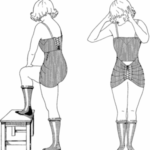A baby bird, perched on a nest on a mountain side, slowly extends its head to look beyond its home. It stretches its immature wings and begins to flap; a vain attempt to fly away from its nest before its time. Likewise, The 1920s youth posses a sanction of young women called “Flappers” (as the vain baby bird was called) which washed over the social norms of that time with wholly new opinions, dress, attitude, and action. With such a quiet rebellion, the Flappers opened the gates for women, to explore uncharted territory and gain unexpected advances. The Flapper, though not taken seriously by many, shook the grounds below the feet of the “old puritans” and opened their eyes to a new and glorious world where opinions were expressed freely and publicly.
Such public expression included the dress the Flappers wore. The “new breed” fashion emerged from the musical style of Jazz and the dancing that usually accompanied it. The theme of their dress was young and boyish. Bobbed” hair became a very popular very short style, which eventually gave way to hair slicked back and curls covering the earls. Corsets and pantaloons were disregarded; the flappers actually wrapped cloth around their breasts to flatten them and gain a more boyish and slim figure (Kyvig 104). Such a look would accompany the flat and loose dress perfectly. Such daring dress allowed arms to be bare and the waistline to drop to the hips. The skirts were just above the knees and the round hat, called a cloche, finished off the look. Makeup, originally restricted to actresses and prostitutes, now was being worn and applied publicly by Flappers. Pale skin, red lips, black ringed eyes were the new “in” among them. Not only did they apply makeup publicly, but they smoked and drank with men publically as well. Such acts flaunted their disdain for decent behavior. Flapper behavior consisted of nothing less risky then their dress. At Jazz clubs they danced provocatively, drove cars and bicycles, smoked cigarettes and dated men that they would possibly have sex with (Wikipedia).
Sex drive ran rampantly in the minds of the young generation, especially the Flappers. Many Flappers attended “petting parties” which allowed physical intimacy without sexual penetration. Petting, a main attraction at such parties, invited the formation of new nouns such as “snuggle pup”, which defined men who frequented petting parties and “bamey-mugging”, which was a cover word for sex. Edna St. Vincent Millay wrote a poem stating:
My Candle burns at both ends;
It will not last the night;
But ah, my foes, and oh, my friends,
It gives a lovely light.
This poem serves as a battle cry of freedom for young people, especially the Flappers. By living their life to the fullest, they are taking advantage of their time on earth and thus the “candle burns at both ends” (Rather 665).
The “battle for freedom” was expressed not only through a poem but through Flapper (as well as the rest of the younger population) opinions as well. Such a generation believed in seven core ideas of : salvation by the child, self expression, paganism, living for the moment, liberty, female equality, and changing place (Rather 664). The idea of salvation by the child stated that the potential of the child was crushed and destroyed by standardized society and especially by the ways of teaching. It was suggested that the educational system should exist to help the child develop his/her own personality. The idea of self expression presented the idea that the purpose in life is to express one’s self. The idea of paganism stated that the body is the temple that has nothing unclean and should be adored and adorned for the ritual of love. Living for the moment was another idea that suggested to seize the moment (much like carpe diem, which means seize the day) and dwell in it intensely even if the cost is future suffering. The idea of liberty radiated the thought that if the law restricted self expression, it should not be followed and should be banished, basically stating in a nutshell that Puritanism is the great enemy. The idea of female equality suggests that females should be economic and moral equals of men. They should receive the same pay, working conditions, opportunity of drinking and smoking and the option of taking or dismissing a lover. The last idea, the idea of changing place, expressed the feeling that by living in famous European cities “the artist can break the puritan shackles, drink, live freely, and be wholly creative” (Rather 665). These seven ideas represented the majority of opinions of the “new breed” to society and its organization.
Despite Society’s overall negative attitude towards the Flappers and all the scandal, the “new breed’s” look became fashionable in a toned down form among respectable women. The Flappers achieved many successes such as removing the corset from female dress, popularizing short hair for women, and introducing shocking dance styles such as the Charleston, Shimmy, Bunny Hug, and Black Bottom. Such advancements allowed modern women to play an integral and lasting part in society. The Flapper attitude seemed to reflect a quiet rebellion running through the twenties, a “rebellion against the values of the generation that made the war and was satisfied with the quality of life” (Snowman 17). The war served as the catalyst for the rebelliousness in the Flappers. During the war, women were encouraged to be assertive and take on the roles of men in the work place. But the time after war also helped shape their personality. Dancing, an inherent subcategory of the newly emerging Jazz era radiated the fact that the Flappers knew every variation of the Fox Trot and mastered the Camel Walk, Tango, and Toddle. The Charleston, once danced by only professionals, became the challenge that the Flappers won and mastered with a quick pace (Perrett 237).
Flappers overall gave a new definition to woman-hood, one that represented a woman who delighted in smoking and drinking in public, danced, cut her hair short, wore makeup, dressed provocatively and confidently participated in jobs. By defiantly going against the norm, they helped place woman in a more respectable and independent position. Although the Flapper image died soon after the stock market crash, its ideas and bold representation remained throughout society. Some of the Flapper ideals can still be seen in today’s society bolder than imaginable. Their goal has placed women’s status somewhat closer to mens. Undeniably, women and men remain unequal to this day, but due to audacious women such as Flappers, women got closer to an equal status to men. The young bird vainly attempted to fly away from its nest, and it seems that it has successfully conquered. Although the wind goes against its wings, the bird is still flying and finding ways to fly with the wind.
Works Cited
“Flapper.” Wikipedia 12 December 2005. http://en.wikipedia.org/wiki/Flapper> . Kyvig, David E. Daily Life in The United States, 1920-1939 Decades of Promise and Pain. Connecticut: Greenwood Press, 2002.
Perrett, Geoffrey. America in the Twenties. New York: Simon and Schuster, 1982.
Rather, Dan. Our time: America at the Birth of the 20th Century. New York: Scribner, 1996.
Snowman, Daniel. America since 1920. New York: Harper & Row, 1968. “The Jazz Age: Flapper Culture & style.” Geocities 8 December 2005. http://www.geocities.com/flapper_culture/?20058


